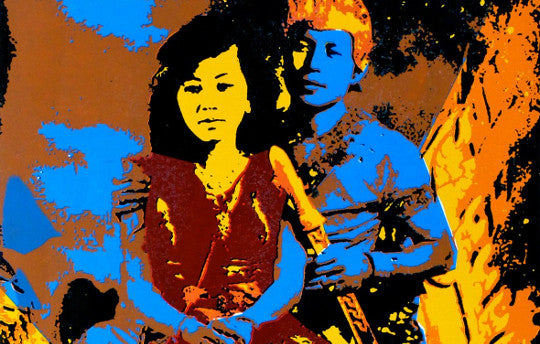Your Cart is Empty

Cambodia's recent musical history is a a bloody one; the majority of musicians and singers were killed in the mass murders of the Khmer Rouge Regime. Nonetheless, traditional classical and folk music continue to exist. Popular music from the golden era of the fifties & sixties, has also managed to survived and was revived from the nineties onwards, in both Cambodia & its diaspora.
Cambodia's Khmer kings ruled over much of mainland Southeast Asia between 802 and 1431. Under their rule, a delicate classical dance style and court music were developed to honour the gods at the temples. This style influenced classical dance across the region and its music remains an essential part of Cambodian life.
Pre-Khmer music still exists in the countryside, for example in the form of dances for spirits in Koh Kong. There is also a call-and-response folk style, lakhon ayai, which involves verbal jousting between a male and female singer. In this folk music the chapay (long-necked lute) player plays a central role. They are also bards, wandering the countryside to sing bittersweet, comic or satirical songs.
There are two major forms of Cambodian dance– classical and folk, which are both taught under the same roof. At first, the classical form borrowed much from the Indian tradition and earlier folk styles, but with time, this developed into a more 'Khmer' style. The dancers are accompanied by a pinpeat orchestra, which consists of a bamboo xylophone (roneat), chapay, flute (pia au), oboe (srlay), two-stringed violin (tro), hand-cymbals, gongs and various drums. During the genocidal rule of the Khmer Rouge however, ninety percent of all classical performers were killed, along with anyone who had a “bourgeois” musical background.
Cambodian classical music has greatly influenced similar traditions in Thailand and Laos and Burma. All of these can be traced back to the “heavenly dancing” at Angkor hundreds of years earlier. Cambodia also has ancient traditions of mask dancing (lakon khol) and shadow plays (nang sbek), both of which can be seen throughout the country.
Despite Cambodia’s recent bloody history, folk songs (ayai) and wedding songs (phleng kar) are still commonly played. The Cambodian government is currently trying to gather and collect material from old Cambodian folk singers. The popular theatre of Cambodia is called Lakon Bassak, which was created by Cambodians in Vietnam at the beginning of the twentieth century. Here, classical dance and music styles are popularised and sound at times like the Vietnamese popular operetta cai luong.
Western music entered Cambodia in the middle of the nineteenth century. French musicians were hired to teach Western music at the Palace this led to written forms of Khmer music and the setting of Khmer tunes to Western orchestration. After the independence from France in 1953, a golden era for songwriter and singers emerged, which lasted until 1970 and known as Sangkum Reastr Niyum (Popular Socialist Community). None of the artists from this time survived the murderous Khmer Rouge, but their influence lives on. At present, local modern styles like ramvong and ramkbach use electrified Western and sometimes traditional instruments.
In the 1960s, local pop and rock music took off which travelled to the West in the mid-1990s, where Cambodian psychedelic pop/rock influenced the growth of “transnational music” through the Cambodian diaspora.